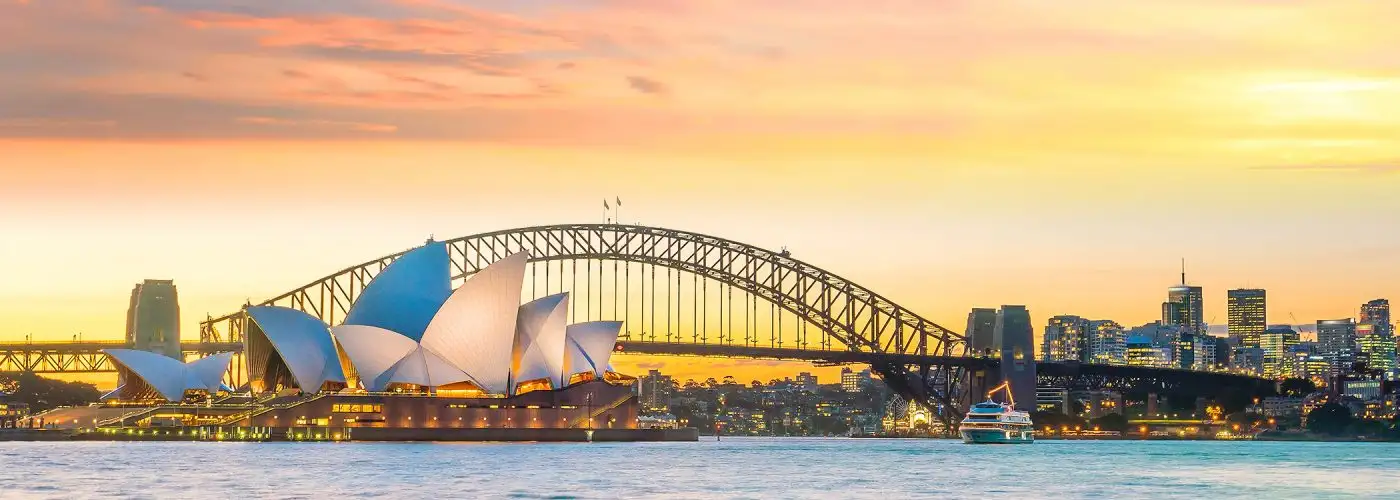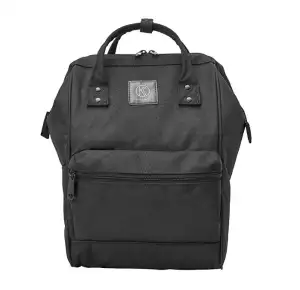Sophisticated and iconic, Sydney, in Australia’s state of New South Wales, is everything a world-class city should be. It’s famous for many things, but especially the Sydney Opera House, the Harbour Bridge, Bondi Beach, and those New Year’s Eve fireworks, placing it firmly on most traveler’s bucket lists.
But is Sydney safe? By most accounts, it is. According to the U.S. Department of State, Sydney crime is comparable to that of most major U.S. cities. In fact, Australia has much stricter gun laws than the U.S. does, making it rare for a crime to be committed by firearm. SafeAround rates Sydney as a low-risk city for pickpocketing, mugging, scams, and terrorism, and notes that what crime Sydney does have tends to affect its locals more than its tourists.
Still, it’s worthwhile to read up on Sydney safety, to know something about Sydney’s dangerous animals, and to be aware of which areas to avoid in Sydney.
Tips for Staying Safe in Sydney
- Stay away from—or at least be on high alert in—higher-crime neighborhoods, including Kings Cross, Redfern, Cabramatta, Fairfield, Campbelltown, Blacktown, Fairfield, Liverpool, Parramatta, and Penrith. Instead, stay in Sydney’s safer areas, such as Bondi Beach, City Center, and Lavender Bay.
- When visiting Sydney’s beaches, beware the strong undertows, which have caused many drownings. To remain safe in Sydney’s waters, stay between the red and yellow flags, and never swim alone, at night, after a large meal, or under the influence.
- Sydney has some truly dangerous animals, including poisonous insects, spiders, snakes, and sea life. If you get bitten or stung, seek medical attention immediately; Australia’s main emergency number is 000.
Top Travel Safety Products for Sydney
Safe Places—and Places to Avoid—in Sydney
Some of the safest areas in Sydney include City Center, City South (except for George Street and Belmore Park, both of which can be dangerous at night), East Sydney, and Bondi, as well as the suburbs of Lavender Bay, Bankstown, Baulkham Hills, Hawkesbury, Holroyd, the Inner West, and the Northern Beaches, among others.
Areas to avoid in Sydney, however, include Campbelltown, which has a high crime rate, as well as Fairfield and Blacktown (listed in a recent report as the Sydney suburb with the most burglaries). Other higher-crime suburbs include Liverpool, Parramatta, and Penrith.
Travelers sometimes question whether Cabramatta and Redfern are safe. The answer for Cabramatta is that, though it was known for brutal gang violence and drug abuse in decades past, recent years have seen the neighborhood (home to many Vietnamese and others who came as refugees) gentrify, and its crime rate lower. Redfern, too, has gentrified, though “the Block” and its Eveleigh Street have historically seen protests, riots, and drug problems. In both of these Sydney neighborhoods, it’s wise to travel in pairs or groups, especially at night.
As for Kings Cross, long considered Sydney’s red light district, it’s a densely populated inner-city neighborhood where brothels are legal and prostitution has been decriminalized. Though “the Cross” is known for bawdy nightlife, alcohol-fueled violence, and muggings, Sydney’s Kings Cross is also known for its colorful and bustling crowds, neon lights, and recent gentrification set in motion by a strengthened police presence and controversial “lockout laws.”
If you visit Kings Cross, be on heightened alert after dark, don’t travel alone, and avoid alleyways and other non-main streets. Also in Kings Cross, be aware of bar and nightclub scams that gouge foreigners for drinks, fake jewelry being sold on the street as real, and strangers trying to distract you as an accomplice picks your pocket or purse. There have also been reports in Kings Cross of locals offering to help carry travelers’ suitcases, then stealing the luggage.
How to Get Around Safely in Sydney
Sydney’s varied public transportation options include subways, light rail, buses, and ferries—and they’re all considered very safe, as are Sydney’s taxi and rideshare services.
Indeed, every taxi cab in Sydney undergoes safety inspections every four months, in addition to being subject to random compliance checks by government agencies. If you’re taking an Uber or Lyft, make sure to share the details of your ride with a friend or loved one. If you’re in a taxi, be aware that, as a passenger, you may be videoed during the trip, starting as soon as you open the car’s door to get in.
While riding Sydney’s trains is generally a safe proposition, you’ll still want to avoid being on mostly empty train cars at night, or hanging out at the Sydney train stations that have the most criminal incidents, including Central, Town Hall, Blacktown, Parramatta, Strathfield, Penrith, and Redfern. According to a study by the NSW Bureau of Crime Statistics and Research, it’s most common for criminal incidents on the rail system to occur in the evenings and overnight, between 6:30 p.m. and 6:00 a.m.
Pickpockets in Sydney aren’t generally a huge problem. As in any major city, follow the standard advice for protecting yourself against pickpockets: Keep your belongings close (under your clothing, if possible), be aware of your surroundings, don’t get distracted by strangers (their cohorts might rob you meanwhile), and invest in a slash-proof backpack or purse.
If you’re traveling by car in Sydney, keep all valuables hidden under seats or in the trunk, and be sure to roll up your windows and keep your doors locked; theft out of a vehicle is one of Sydney’s more common crimes.
In terms of terrorism, Sydney is considered a medium-threat location; there have been a smattering of minor terror incidents around Australia in recent years, as well as a number of foiled attempts. If you find yourself in a terrorist situation, run to escape, if possible, and follow all instructions given by local authorities.
Finally, if you’re not interested in experiencing the inside of an Australian prison, steer well clear of illegal drugs, which are on the rise in Sydney: Cocaine possession and use in Sydney has seen a recent increase of more than 40 percent.
Weather Risks and Natural Disasters in Sydney
During Australia’s sweltering summers, Sydney can experience extreme heat, and large-scale fires sometimes occur in the areas surrounding the city. Information regarding the locations of bushfires is available at NSW’s Rural Fire Service website, while a website run by NSW Emergency Management helps people in Sydney prepare survival and escape plans for fires, storms, floods, and tsunamis. The likelihood, though, is that you won’t encounter any of these natural disasters while visiting Sydney.
Travelers should always wear sunscreen and protective clothing, and stay hydrated enough to tolerate Sydney’s strong sun, which can burn skin in as little as 15 minutes.
If you’re planning to visit Sydney’s beaches or swim in the ocean, know that strong currents, known also as riptides, can be very dangerous. Case in point: Australian prime minister Harold Holt went for a solo swim one day in 1967 and never returned; the country’s sitting leader was presumed to be one of the many victims of Australia’s deadly undertows.
To avoid sharing his fate, swim only in areas that are patrolled by lifeguards—between red and yellow flags, that is—and never swim alone, at night, on a full stomach, or after you’ve had alcohol.
Spiders, Snakes, and Other Dangerous Animals in Sydney
When people question whether Sydney is dangerous, often they’re wondering not just about the people, but about the critters, too. Spiders and snakes in Australia are notoriously venomous, and so are the sea creatures (you may recall that Steve Irwin was killed by a stingray off Australia’s northern coast).
Other dangerous animals in Sydney that travelers should be aware of include sharks and crocodiles, though the average number of people killed annually by dangerous animals in Australia each year is minuscule.
Still, there are other deadly animals to know about in Sydney: the Australian paralysis tick, the Sydney funnel-web spider, the common death adder (a woodland snake recognizable by its triangular head and short body), and the southern blue-lined octopus, whose venom is one of the world’s most potent. If you get stung or bitten by an animal in Sydney, seek medical attention as soon as possible. The emergency phone number in Australia is 000; if you have trouble getting through, you can try the secondary emergency number, 112, from a mobile phone.
More from SmarterTravel:
- 9 Free Things to Do in Sydney, Australia
- 11 Things Locals Want You to Know About Australia
- Tipping in Australia: The Australia Tipping Guide
—original reporting by Avital Andrews
Editor’s note: This story was originally published in 2017. It has been updated to reflect the most current information.
We hand-pick everything we recommend and select items through testing and reviews. Some products are sent to us free of charge with no incentive to offer a favorable review. We offer our unbiased opinions and do not accept compensation to review products. All items are in stock and prices are accurate at the time of publication. If you buy something through our links, we may earn a commission.
Related
Top Fares From
Today's Top Travel Deals
Brought to you by ShermansTravel
Kenya: 14-Night Tour, Incl. Tanzania &...
smarTours
 vacation
$7125+
vacation
$7125+
7-Night Bermuda Cruise From Round-Trip Cruise...
Norwegian Cruise Line
 cruise
$1036+
cruise
$1036+
Ohio: Daily Car Rentals from Cincinnati
85OFF.com
 Car Rental
$19+
Car Rental
$19+







